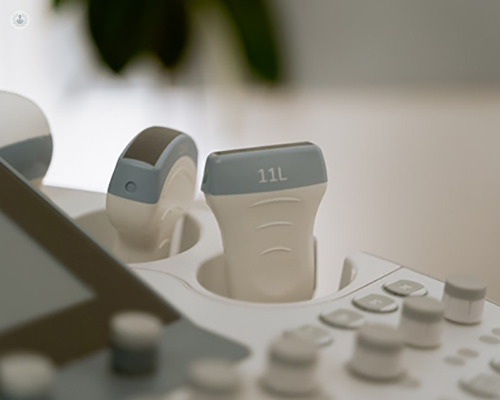Breast ultrasound
What is a breast ultrasound?
A breast ultrasound is an imaging technique used to screen for tumours and abnormalities in the breast tissue, such as cysts. An ultrasound uses sound waves to form images of the inside of the body. The sound waves bounce or echo off surfaces in the body which are recorded and transformed into videos or photographs.

What does a breast ultrasound involve?
Prior to a breast ultrasound a doctor will have conducted a physical exam of the breast. Then you will have to undress from the waist up and lie down on the examination table. A clear gel is applied to the breast being examined. This gel is harmless and helps the ultrasound produce clearer images. A paddle-like probe instrument is applied to the breast and moved across it. A test will take between 10-20 minutes. Once the relevant images have been recorded, the gel is wiped off and the procedure is complete.
Why is a breast ultrasound done?
A breast ultrasound is most commonly performed if there is a suspicious lump found in the breast. This lump could be a sign of breast cancer and an ultrasound will help determine whether it is a tumour or a fluid-filled cyst. Although a breast ultrasound can detect a tumour, it is not able to determine if it is cancerous or not. A biopsy will be performed to determine this, which can also be guided by ultrasound.
Preparation for a breast ultrasound:
No preparation is required for a breast ultrasound, however, it is advised not to apply perfumes or lotions to the breast skin. It might also be helpful to wear a two-piece outfit to the test to aid undressing.
How does a breast ultrasound feel?
A breast ultrasound is painless, however, the gel applied can feel a little bit cold.
What do abnormal results mean?
The ultrasound images are black and white, and a lump or abnormality will usually show up as dark.
The following are potential findings from a breast ultrasound:
• Fibrocystic breasts – painful and lumpy breasts caused by hormonal changes.
• Adenofibroma – a benign, non-cancerous breast tumour.
• Intraductal papilloma – benign tumour of the milk duct.
• Malignant tumour – a cancerous breast lump.
A cancerous tumour will be tested further, usually by an MRI scan and then a biopsy. These further tests will confirm whether or not the lump is cancerous.











